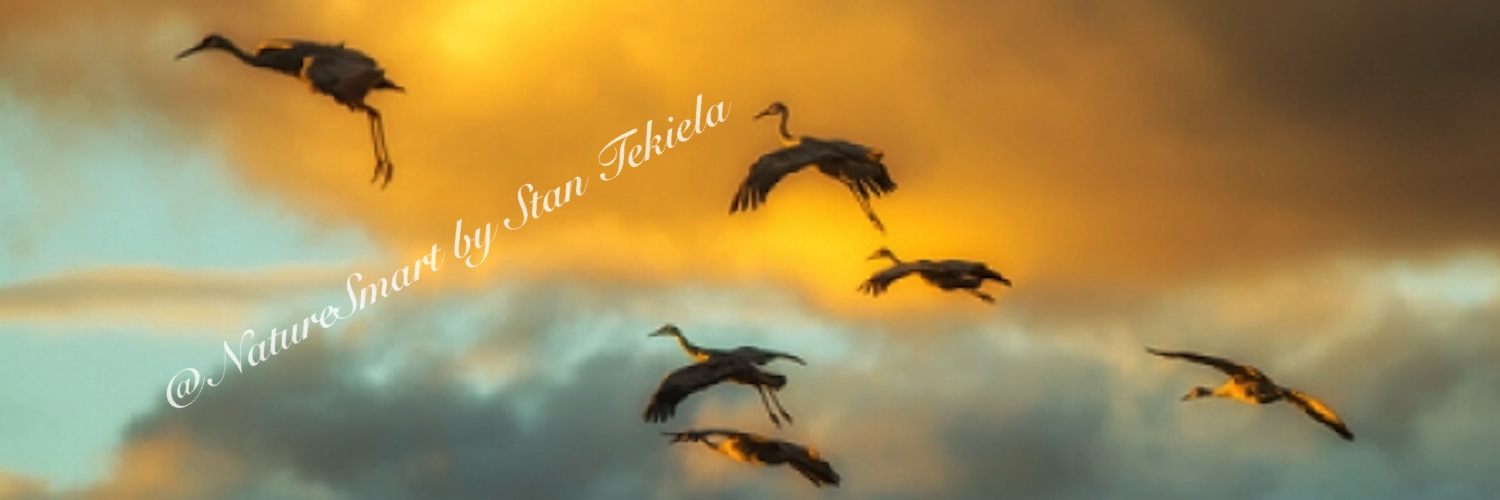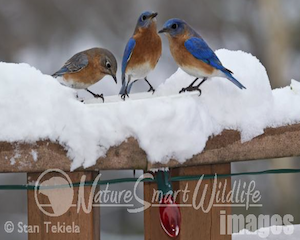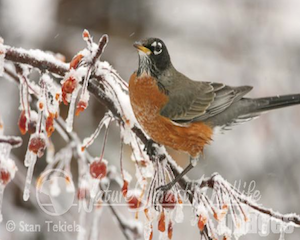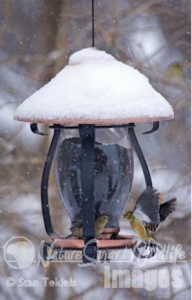
Winter—A Challenge for Our Resident Birds
In this week’s column, Stan Tekiela discusses how challenging winter can be for birds.
 Winter can be a very challenging time for the birds who don’t migrate. The rigors of winter, lack of food, reduced access to fresh water, and extremely long and cold nights do represent a lot of challenges for our resident birds.
Winter can be a very challenging time for the birds who don’t migrate. The rigors of winter, lack of food, reduced access to fresh water, and extremely long and cold nights do represent a lot of challenges for our resident birds.
The other evening I was out filming a pair of Barred Owls. The sun had set and the blue shadows of winter descended upon the landscape. I call this the cobalt hour: after the sun sets, when everything outside is cast in a cobalt blue color. It’s a magical time of a winter day.
I was hiking back to my truck with my oversize camera and tripod hoisted over my shoulder when I heard a Pileated Woodpecker giving a loud call. Glancing to my left, I saw our largest woodpecker species land on a dead tree and slip into a former nesting cavity. Plainly, I could see this bird was in for the night. Roosting in cavities is a great strategy for saving energy and lowering the risk of being eaten by an owl or other nighttime predator. If a bird roosts in a cavity by itself, studies show that it can raise the interior temperature of the cavity by several degrees. If it roosts with a second or third bird, they can together raise the temperature upwards of 15 degrees. Compared to the outside air temps, this often makes a big difference.
 Many of our winter birds roost in cavities overnight. Chickadees and nuthatches are good examples. This could be one of the best arguments for leaving dead trees standing and not cutting down everything that is not alive. Most woodpeckers excavate their nesting cavities in dead trees, not live ones, so if you are concerned about birds it’s time to think about dead trees differently.
Many of our winter birds roost in cavities overnight. Chickadees and nuthatches are good examples. This could be one of the best arguments for leaving dead trees standing and not cutting down everything that is not alive. Most woodpeckers excavate their nesting cavities in dead trees, not live ones, so if you are concerned about birds it’s time to think about dead trees differently.
Many of our wintering birds, such as cardinals and blue jays, spend the night perched out in the open on the branch of a tree. Often they will seek out a conifer tree for some added protection, but they are still just sitting on a branch all night long—even if the wind is blowing hard or there is a big snowstorm. These birds are often vulnerable to predators such as owls. In the dark, these birds are like sitting ducks that can be plucked off the branch.
 Finding food in winter is also a challenge for our winter residents. Birds that are dependent upon insects are plum out of luck. If you live in an area that gets below freezing, which most of the country does, insects are dormant during winter. So the insect eaters are long gone. That leaves fruit and seeds as the only alternatives. If you are not a seed eater, it can be slim pickings.
Finding food in winter is also a challenge for our winter residents. Birds that are dependent upon insects are plum out of luck. If you live in an area that gets below freezing, which most of the country does, insects are dormant during winter. So the insect eaters are long gone. That leaves fruit and seeds as the only alternatives. If you are not a seed eater, it can be slim pickings.
Birds such as Cedar Waxwings are classic fruit eaters. During winter they gather in small- to medium-size flocks. Both adult and juvenile birds stick together all winter. The collective eyes of all these birds help them to spot food and avoid predators.
 After spying a crabapple or other wild fruit source, the flock lands in a nearby tree as if they are waiting to see if it is safe to approach. Then, one by one, they come to the fruit to eat. They are often in the fruit tree for just a few minutes, gobbling up as many berries as they can strip from the branches. Then, like a shot, the entire flock is off like a flash, back to the top of the tallest tree.
After spying a crabapple or other wild fruit source, the flock lands in a nearby tree as if they are waiting to see if it is safe to approach. Then, one by one, they come to the fruit to eat. They are often in the fruit tree for just a few minutes, gobbling up as many berries as they can strip from the branches. Then, like a shot, the entire flock is off like a flash, back to the top of the tallest tree.
Planting and maintaining fruit trees, especially native species, is as important as leaving some dead trees to stand. So, if you gander into your backyard and don’t see a single fruit-bearing tree, there might be a problem. Perhaps this will give you a project for next spring. Until next time…
If you enjoyed Stan’s post, you may consider one of his amazing nature books: Majestic Eagles; The Lives of Wolves, Coyotes, and Foxes; or Backyard Birds: Welcomed Guests at our Gardens and Feeders. Young readers will delight in his award-winning children’s books, such as Whose Butt?, Critter Litter, and his latest, Jump, Little Wood Ducks.
You can follow Stan on Facebook and Twitter, or contact him via his web page. Stan’s nationally syndicated NatureSmart Column appears in more than 25 cities spanning 5 states (Minnesota, Wisconsin, Michigan, Illinois, and Pennsylvania) and is circulated to more than 750,000 readers. Stan’s author page on Amazon features some amazing videos! Check them out, and follow him for updates.
For more stories about wildlife and nature, sign up for our newsletter now!
More posts from Stan:
Indigo Bunting—A Familiar Summer Visitor
The Nesting Behaviors of Sandhill Cranes
Big Birds, Baby Birds, Birds Everywhere
Stan Tekiela observes Marsh Wrens
The Magical, Mystical World of Sandhill Cranes


